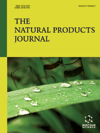- Home
- A-Z Publications
- Natural Products Journal, The
- Previous Issues
- Volume 3, Issue 2, 2013
Natural Products Journal, The - Volume 3, Issue 2, 2013
Volume 3, Issue 2, 2013
-
-
Antioxidant and Anti-proliferative Activities of Astaxanthin Extracted from the Shell Waste of Deep-water Pink Shrimp (Parapenaeus longirostris)
More LessAuthors: Assaad Sila, Yosra Ayed-Ajmi, Nadhem Sayari, Moncef Nasri, Oscar Martinez-Alvarez and Ali BougatefShrimp processing waste is the single largest industrial waste in Tunisia causing diverse environmental problems. Extraction of astaxanthin from the shell waste of the deep-water pink shrimp (Parapenaeus longirostris) was investigated. A hight astaxanthin yield was obtained using acetone (72.42 µg/g). Thin layer chromatographic separation of carotenoid extracts from P. longirostris yielded three distinct bands. The Rf values for th Read More
-
-
-
Extraction of a Polysaccharide from the Skin of Ray Raja montagui by Free-Radical Depolymerization with Metallic Catalysis
More LessAuthors: Mohamed B. Mansour, Mohsen Hassine and Raoui M. MaaroufiThe large production of sulfated polysaccharides was routinely investigated by various procedures such as enzymatic method and acid hydrolysis. The free-radical depolymerization applied directly on the skin of ray constitutes an efficient method and an original process to produce bioactive compounds in large amount and good reproducibility. The depolymerized sulfated polysaccharides fractions obtained from the skin of ra Read More
-
-
-
Evaluation of Biochemical Properties of Digestive Lipolytic Enzymes from the Marine Snail (Hexaplex trunculus)
More LessAuthors: Zied Zarai, Nabil Miled and Hafedh MejdoubUnlike classical digestive lipolytic enzymes, the marine snail digestive lipase (mSDL) and marine snail digestive phospholipase A2 (mSDPLA2) showed maximal activities at a high temperature (50°C) and at pH 8.5. Both lipase and phospholipase A2 activities were remained stable in the presence of organic solvents. Phospholipase activity was calcium dependent, since no significant activities were detected in the presenc Read More
-
-
-
Marine Collagen as a Source of Bioactive Molecules: A Review
More LessAuthors: Ailen Aleman and Oscar Martinez-AlvarezSkins, scales and bones are the major by-products of the fish-processing industry. These by-products are not regarded as ordinary saleable products and are usually discarded causing a heavy environmental impact. However, marine by-products are a good source of collagen that could be extracted and further enzymatically hydrolyzed to liberate interesting bioactive peptides. Collagen-derived peptides may exhibit inter Read More
-
-
-
Effect of Enzymatic Hydrolysis on the Interfacial and Surface Properties of Cuttlefish (Sepia officinalis) Muscle Proteins
More LessAuthors: Rafik Balti, Ali Bougatef, Pascal Dhulster, Moncef Nasri and Naima Nedjar-ArroumeEnzymatic hydrolysis of proteins from marine resources could be produced for uses like functional ingredients in a wide and always increasing zone of application in different food products. The objective of this study was to examine the effects of enzymatic hydrolysis on the interfacial and surface properties of cuttlefish (Sepia officinalis) muscle proteins. Two microbial enzymes (Alcalase® 2.4 L and Bacillus licheniformis NH Read More
-
-
-
Fish Amylolytic Enzymes: Biochemical Characterization and Application for Oligosaccharides Production
More LessAuthors: Noomen Hmidet, Ali Bougatef and Moncef NasriIn order to utilize some fish by-products, which are normally discarded as industrial waste in the process of fish manufacture, digestive amylases of barbel (Barbus callensis), grey triggerfish (Balistes capriscus) and sardinelle (Sardinella aurita) were extracted, characterized and used for specific oligosaccharides generation. Starch zymography study shows that the crude amylase extract of Sardinelle contained at least two clear z Read More
-
-
-
In Vitro Synergistic Anti-yeast Activity between Galloyl Derivatives and Amphotericin B
More LessA collection of both commercial and non-commercial galloyl derivatives (either isolated from plants or synthesized) was examined for an in vitro structure-activity relationship (SAR) screening of their anti-yeast activity. Most of the compounds exhibited an antimycotic activity when used together with amphotericin B (AMB) and none when used alone. The SAR study indicated the presence of two galloyl moieties in adjacen Read More
-
-
-
Chemical and Biological Aspects of the Genus Verbesina
More LessAuthors: Flor D. Mora, Lara Alpan, Vance J. McCracken and Marcelo NietoThe current paper reviews the published literature up to March 2012 regarding the phytochemical components and biological activities of Verbesina species (Asteraceae). A compilation of compounds isolated from several members of this genus is presented. Eudesmanes are the most common secondary metabolites found within this genus. Flavonoids, guanidine alkaloids, acetylenic compounds, and several other terpenes with Read More
-
-
-
Separation of Bioactive Metabolites from Aphanothece Halophytica Through HPLC and Characterization of the Analytes Through ESI-MS and NMR
More LessAuthors: Rashi Vishwakarma and Ashwani Kumar RaiSeparation and retention of both polar and nonpolar compounds by the same stationary phase can be a useful approach for analyses of complex samples. Biological samples encompass a broad range of polarities and varied chemical properties. A gradient elution run with acetonitrile-water as the mobile phase was used for the separation of polar and non polar compounds from Aphanothece halophytica using ODS C18 column Read More
-
Most Read This Month
Article
content/journals/npj
Journal
10
5
false
en


